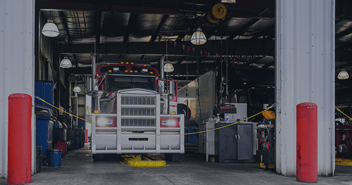
Top Reasons For Roadside Inspection Failure
Every carrier will likely undergo at least one roadside inspection within their career. While it is not uncommon, failing a roadside inspection will affect your safety score and could lead to costly fines and out of service orders.
In this blog, we are going to list out the top 10 roadside inspection violations and explain how you can avoid these violations:
- Lights
Burnt-out or flickering lights will lead to being pulled over. Regularly check and maintain your vehicle's lights to avoid this issue. - Brakes
Make sure your brakes are clear of rust and foreign objects, aren’t leaking fluids and are properly adjusted. Check brake pads and lining for excessive wear and cracks. These simple issues could lead to potential braking malfunctions or a failed inspection. - False Record of Duty Status/Logbook
Drivers must maintain a current and accurate Record of Duty Status. The Drivers Record of Duty Status must accurately reflect the drivers’ daily activities and changes in duty status. Law Enforcement will check a driver’s Logbook to ensure compliance with Hours-of-Service requirements. If your driver’s log isn’t up to date or accurate you will face an inspection failure. - Lack Of Emergency Equipment
Make sure you have the required equipment on board your vehicle for emergencies. You should always have a charged and secured fire extinguisher(s), one spare fuse for each type of fuse needed for your equipment and at least 3 early warning devices to warn approaching traffic if you must park your vehicle on the road. - Outdated Annual Vehicle Inspection
Stay on top of your vehicle inspections to ensure they are up to date. Some States required drivers to have both the Inspection Sticker and paper Inspection sheet in their possession. - Tire Issues
Worn-out, deflated, or damaged tires can result in a failed inspection. Regularly inspect and maintain your tires for safety. - Improper Load Securement
Make sure to secure your cargo by using the required number and type of securement devices. The load securement devices need to be in working condition, under adequate tension and applied as required. This prevents cargo loss and reduces the risk of accidents caused by items falling off your trailer. - Hours of Service Violations
The purpose of the Hour of Service requirements to prevent driver fatigue. There are many exemptions granted for specific situations to the Hour of Service regulations. Generally, drivers shall not drive after working 14 hours. Drivers may not drive more than 11 hours in any 14-hour period. To “re-set “these limits, a driver needs to take a 10-hour break. Make sure you are adhering to these regulations to prevent inspection failure. - Medical Card Violation
Keep your medical card up to date and readily accessible in your cab to avoid compliance issues. - False Record Of Duty Status
Yes, this is the third time we’ve mentioned Record of Duty Status, it’s that important. Faking your Record of Duty Status is a serious violation and can lead to severe consequences. Make sure to keep your records accurate at all times.
How To Prevent Roadside Inspection Failure
To avoid failing roadside inspections, ensure you don't do anything to attract the attention of authorities and get pulled over. About 35% of roadside inspections stem from speeding violations, while another 31% are prompted by observable defects like brakes, lights, and tires.
While you have full control over speeding, you can also prevent being pulled over for observable defects – like lights, brakes, and tires - by conducting a thorough pre-trip inspection. For a detailed guide on how to perform a pre-trip inspection, check out our blog – A Carrier’s Guide To Properly Performing A Pre-Trip Inspection.



